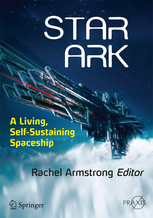Star Ark: A Living, Self-Sustaining Spaceship:
Think of the ease. With a simple command of “Make it so” humans travelled from one star to the next in less time than for drinking a cup of coffee. At least that’s what happens in the time-restricted domain of television. In reality it’s not so easy. Nor does Rachel Armstrong misrepresent this point in her book of essays within “Star Ark – A Living Self-Sustaining Spaceship“; a book that brings some fundamental reality to star travel.
Yes, many people want to travel to other stars. We’re not ready for that. We’re still just planning on getting outside Earth’s protective atmosphere (again). Yet making preparations and doing judicious planning is the aim of this book. Wisely though, this book isn’t technical. It has no mention of specific impulse calculations or ion shields. Rather, this book takes a very liberal view of space travel and ponders deep questions such as whether the cosmos is an ecosystem.
Does our species have an appropriate culture for space travel? What exactly is a human? These concerns get raised in some very thought provoking sections. And given that the editor is an architect and one who apparently considers the emotional qualities of a structure as much as functional qualities, then this book’s presentation tends to be a little more on the philosophical side of things.
In particular, it looks at the benefits of living entities. For instance it notes that humans live in symbiotic relationships with a host of internal and external organisms. Most have already gone into space either within people who have traveled in space or possibly upon probes sent to other planets. So we aren’t the only species that’s traveled beyond Earth. But which beings are sufficient and necessary to keep humans alive for the generations needed to travel to another star? That question and many answers come up often.
As well, the essays get into bigger questions such as: What is life? Could the vessel be an organic construct? How might today’s humans evolve to tomorrow’s star travelers? Should humans travel in space and promote/continue panspermia? Yes, these questions and many more are raised in the essays collected within this book. And true to form for any book considering star travel, there aren’t any strict answers. There are however lots of ideas and concepts to better prepare humans.
Much of this book seems to center around the authors’ involvement with the Persephone project of Icarus Interstellar. Yet there’s very little description of either. However, the book does have wonderful descriptions of Biitschli experiments, explanations of living walls and critiques of theatrical productions.
There are a few fictional passages and some poetry. The long list of references indicates a broad knowledge of the technical issues, though the focus is on humanity and the living aspect. This focus flows through the essays, but having a collection of many authors makes for a disjointed flow. The writing styles are unique, the viewpoints are particular and the emphasis specialized for each. One common viewpoint does keep arising though. That is, we are already on a living spaceship; the Earth. Earth gives a unique platform for assessing the ability to travel to other stars. The essays state that it is or at least was a veritable, closed self-sustaining life support system. And, as seems to be the norm these days, the essays acknowledge that solutions for space travel would be just as good for people remaining behind upon Earth or travelling to the Moon or to Mars and so on. This care and concern for living organism keeps the book grounded, so to speak.
The all-encompassing-solution-finder may be a strength or a weakness to Rachel Armstrong’s collection within the book “Star Ark – A Living Self-Sustaining Spaceship”. As the book’s essays describe, humans have an incredible ability to think and act in abstract fashion. Just envisioning an attempt to send sentient beings to another star demonstrates this. But will we be able to enact this idea and what form might a star vessel take? Reading of this is easy. Will taking the necessary steps be just as easy?
The book is available here through Springer.
Learn more about the author, Rachel Armstrong, here.
The post Star Ark: A Living, Self-Sustaining Spaceship appeared first on Universe Today.
Photos of Nature, Nature Photography Across The Universe. All about Nature, Love, Travel, Beautiful Photo, Landscape, Sunset, Summer, Mountains, Flowers, Photographer, Wallpaper, Portrait, Photo, what is the Universe
Photos of Nature | Nature Photography What is The Universe
Subscribe to:
Post Comments (Atom)

No comments:
Post a Comment